Chris Baty's Blog, page 178
October 31, 2014
"*fog pours in*
It’s close to midnight, and NaNoWriMo’s lurking in the dark
Under the..."
It’s close to midnight, and NaNoWriMo’s lurking in the dark
Under the moonlight, your lack of outline almost stops your heart
You will not scream, your inspiration comes because you’ll make it
You cannot freeze, your novel looks you right between the eyes
You’re energized
‘Cause this is NaNo-oooo! NaNo night!
And no one’s gonna save you from the plot about to strike
You know it’s NaNo! NaNo night!
You’re writing for your life to share a marvel, novel tonight!”
- Merry NaNo, and a happy Halloween to you all.
Road Trip to NaNo: Dream for All It's Worth
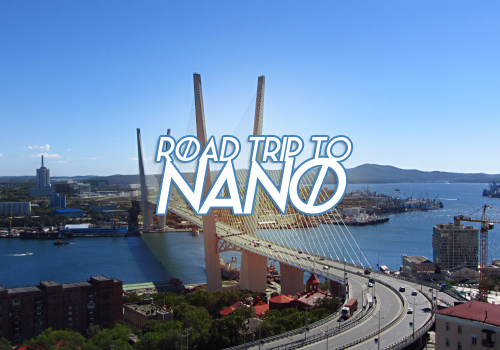
NaNoWriMo is an international event, and the stories being written every year reflect our hundreds of participating regions. We’re taking a Road Trip to NaNo to hear from our amazing volunteers and writers all around the world. Today, on our final stop, Nadezhda, our Municipal Liaison in the Russia :: Elsewhere region reminds you never to give up on your dreams:
For over a century, the citizens of Vladivostok had dreamed of a bridge over the Golden Horn Bay. It would be an intimidating task, but the dream was strong. In 1891, the project to build this bridge received the blessing and full support of the visiting Crown Prince Nikolai. People rolled up their sleeves, ready to tackle the task at hand, convinced it wouldn’t take long if only they all worked on it together.
Then history decided otherwise.
And so the decades flew by, generations came and went, two World Wars claimed their toll, the country itself changed its name and political systems twice—and yet we never gave up on this dream of a bridge.
A man without a dream is like a bird without wings
Dreams, imagination, and the creative approach have always been a part of what is called “the mysterious Russian soul”. From the first explorers of Siberia and the Arctic to the first woman to serve as captain of an ocean-going ship to the first man in space: we have chased our dreams of reaching out and touching the unknown.
There is an old Russian proverb that says: “A man without a dream is like a bird without wings.”
Maybe you have dreamed of creating something amazing: a whole new world waiting to be discovered. What you need to do is build a bridge called “Novel” to share your dream with a reader.
In the end, it won’t even matter this is your first NaNoWriMo ever or your tenth. When you sit down on November 1 and put your fingers on the keyboard, or your pen to paper, it won’t be just a blank page you will see before you. It will be your dream staring you in the face, daring you to achieve the impossible.
He who wants, can
Two years ago, during a particularly beautiful August, the bridge over the Golden Horn Bay in the city of Vladivostok was opened. It took three years of around-the-clock construction, suffered one fire, and caused numerous traffic jams. And now, there it was—our dream of over a century.
So unleash your imagination and keep dreaming for all it’s worth; don’t hold yourself back. Never give up on your dreams. It most certainly won’t be easy, but when did anything worth doing come easy? Remember one thing. Dreams can come true. Bridges can be built. And guess what? You’re the one to build them.
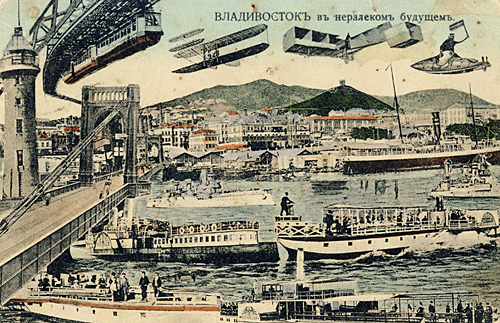

Nadezhda is an ex-athlete with an unrealised dream of the Olympics. This has resulted in 2/3 of her plots revolving around sports. Her competitive streak has also conveniently found an outlet in the traditional word wars with Moscow she leads every November, and which Elsewhere in Russia has won for two consecutive years. She adores her two cats and dreams of someday learning to fly an airplane.
October 30, 2014
Road Trip to NaNo: Infusing Your Novel with Mood
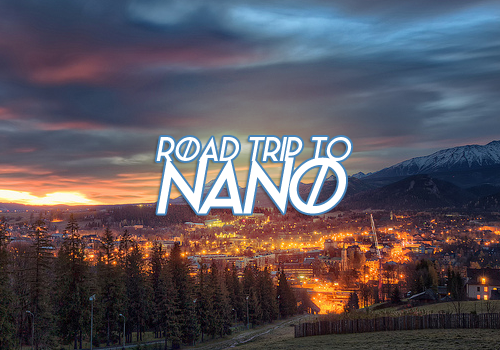
NaNoWriMo is an international event, and the stories being written every year reflect our hundreds of participating regions. We’re taking a Road Trip to NaNo to hear from our amazing volunteers and writers all around the world. Today, Magdalena, one of our Municipal Liaisons in the Europe :: Poland region talks about the power of setting a mood:
In Poland, we have this game we play every year on November 11. A challenge, if you will, because why not crown this extreme caffeine-induced haze of madness with another hurdle? Each year, on our Independence Day, we dare our Wrimos to insert two words—“eleven” and “owls”—into their novels. Owls have become a symbol of NaNoWriMo in Poland.
Cool, right? We have a mascot. Even cooler when you consider that owls generally stand for two things: wisdom and the grim stuff. They can be harbingers of death, messengers of dark powers, or simply bad omens. Combine that with the extremely melancholic All Saints Day (which in Poland suitably falls on November 1), and you get a mood so dark you start to understand why so few of our Wrimos write comedy.
So yeah, let’s talk about mood.
It’s my personal favourite. It’s subtle, omnipresent and powerful. Skilfully used, it can carry the reader through your whole novel. Mood is like the background of a picture—think how much can change with that. When everything else fails and I get stuck in a story, I always rely on atmosphere to get me out of a corner.
You need to know what you are going for in a scene. You know your plot point, you know your characters, you know what’s going to happen: that’s the picture. Now decide on the background. Is it nervous and tense? Or light, relaxed? Or maybe your first-person narrator is delusional with fever, and everything is just slightly off? Whatever it is, know the aim. Even though I’m a big fan of improvisation, I promise you: in this aspect, wandering blind just won’t work.
Needless to say, you can’t create your desired atmosphere by simply stating it! “The mood was tense” or “Everyone felt calm”. It has to be built piece by piece, detail by detail, around your characters. They don’t just have to feel the atmosphere, they can also create it, too. Engage all their senses; make them move: tap on the glass, sweat, bite their lips, and murmur to each other. Show their emotions, either in action or in narrative. They are the most dynamic tool you have–use it.
Finally, when you have your aim in mind, and the character details to achieve it, all you have to do is word it correctly. Choose words with the right connotations; don’t write about fluffy clouds dotting the blue sky in a noir novel.
So let me extend the invitation: create a mood. And if you feel like it, you’re welcome to participate in our Independence challenge. On November 11, insert eleven owls into your novel. After all, they are pretty cool birds.


Magdalena Owczarek is a Polish ML whose first published book is, in fact, a NaNoWriMo novel. She will sell her soul to Satan for a good plot twist (but it has to be like really good), and the ability to walk in high heels. She hates describing herself in third person.
Top photo from Flickr user NicoTrinkhaus. Kick-off photo and bio photo by Marta Magdalena Lasik.
October 29, 2014
Road Trip to NaNo: Building Characters that Work as a Team
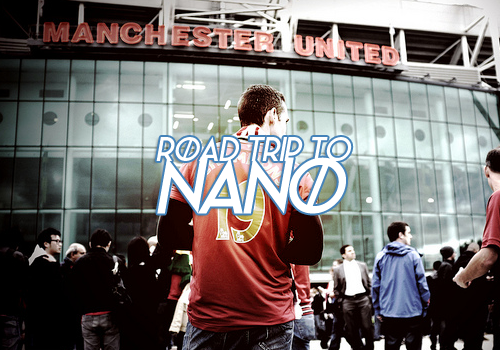
NaNoWriMo is an international event, and the stories being written every year reflect our hundreds of participating regions. We’re taking a Road Trip to NaNo to hear from our amazing volunteers and writers all around the world. Today, Tommeh, one of our Municipal Liaisons in the Europe :: England :: Elsewhere region advises you on how to create a cohesive team of characters:
Welcome to Manchester! Be sure to stop by Old Trafford to catch a Manchester United game while you’re here, or grab your bathing suit and dive into the Olympic-sized swimming pool at the Aquatics Centre that played host to the Commonwealth Games in 2002. What better city, the birthplace of the Mighty Reds, to understand the dynamics of teamwork.
Teamwork is a funny thing. You don’t notice it much when you are in the middle of it. Take football for instance: when the secondary striker moves the ball upfield they simply trust that the center forward is going to be near the goal to score the game-winning point. It’s instinctive. But as spectators, we can see how the entire cast works together toward a common goal. The game isn’t won by one player, its won by a team.
The same can be said about your characters…
They have to become living, breathing creatures with a supporting team to make them believable. Breathe life into them and bring them out of Flatland, as Sheldon Cooper would say, and pull them into glorious 3-D. Remember, your characters do not live in a vacuum. It takes an entire team to mold and shape them.
They need a family. Mother, father, in-laws, step-parents, or siblings. They need a best friend, a mortal enemy, a sexual rival; they need Brenda in accounting that brings them a bagel in the morning and delivers the scoop on office politics. The supporting team for your character gives them a backstory; it gives them history. If your character is a big sister, like me, they might be more of a mother figure than the lone-wolf, only-child character. The lone wolf character might be a little more adept at creating secondary familiar circles.
Once you’ve created this team, you have to learn how to use them effectively. Nothing kills a team faster than a showboat or a ball hog. Your main character is the star of the team, the center of the universe, the David Beckham, but he or she can’t win the game alone. Figure out a role for each member of your supporting cast. Your Beckham should be driving the story, moving the ball toward the goal. Your antagonist should be the goalie for the rival team, stopping the protagonist from scoring. Your second striker should be the sidekick helping Beckham navigate the pitch. The centre midfielders could be the parents who want the best for Beckham, but mostly stay in the wings.
Try using an actual player diagram to help you visualize each character’s role on your team. Keep it in your story binder for easy access and safe keeping. When your characters all work together, the hat tricks roll effortlessly. The story flows, the plot moves forward, and you might just find yourself holding up that Championship Cup.
Tommehbell constructed her first story after she watched Michael Jackson zombie-walk across her screen and onto the page of her Lisa Frank notebook. She grew up in Germany, the firstborn daughter to Army parents. In 2010, she penned her first NaNoWriMo novel while studying abroad in Manchester, England, rediscovering her love for writing. Since that first attempt, Tommeh has graduated from the University of North Carolina at Greensboro, moved back to Manchester and started a Creative Writing masters program at Manchester Metropolitan University. She is working on her second NaNo-novel.
Top photo by Flickr user Paolo Camera.
October 28, 2014
Road Trip to NaNo: Build a Solid Foundation for Your Setting
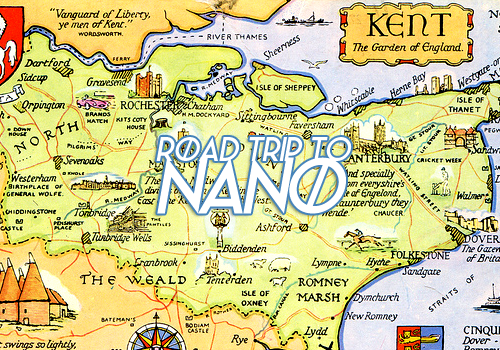
NaNoWriMo is an international event, and the stories being written every year reflect our hundreds of participating regions. We’re taking a Road Trip to NaNo to hear from our amazing volunteers and writers all around the world. Today, Richard, one of our Municipal Liaisons in the Europe :: England :: Kent region shares how to build a foundation for your novel’s setting:
Welcome to the Garden of England, otherwise known as the beautiful County of Kent. With rolling fields of lavender, the white cliffs of Dover, and many historical towns including Rochester, Canterbury and Royal Tunbridge Wells, what better place could there be to stop and soak in atmosphere and scenery to influence your writing.
When you think of the inspiration that people have drawn, look no further than the Canterbury Tales, and, of course, Great Expectations. When you are travelling through, don’t forget to stop at our cathedrals, castles and, of course, numerous bunkers and wartime buildings. There is something here for everyone, and you will all take something away.
One of the most important things you will take away with you is the vast variety of locales that you could set your novels in. From quaint little villages and modern towns, to castles and churches, you can live and breathe your story, just by closing your eyes.
And this is what your readers will do…
Having a living, breathing environment in which your characters live their lives will make the whole story that little more realistic to your reader, and enable them to engage in the story. If you set the environment right, your readers will actually be able to walk around the setting with them. Of course, the setting is much more than just the physical places your novel takes place in. It is also about where your character has come from, and the environment that they developed in to make them the person they are today. What kind of family did they come from? What school did they go to?
Stop for a moment and think about your favourite novel. Remember how you felt, immersing yourself in its surroundings, following those characters around corridors, across fields and even crossing oceans. During NaNoWriMo, the goal is to write your novel in a month. Being able to quickly call upon the setting is key.
Even if you create a fantasy world, having the basics grounded in an area you are familiar with will enable you to draw your setting up quickly. I remember when I was young, playing in the woods. No matter what story I was telling, or what my imagination was creating, the trees were always in the same place. In the same way, having set buildings or locations in mind will enable you to build a world quickly around those sites.
This is therefore my advice to you. Color in your novel’s settings with elements of places you know, even if just to act as a foundation to be built upon. An environment you know will be easily called upon during this month, make a great base for your characters to develop in, and help the reader call the location to mind.
Good luck during November!
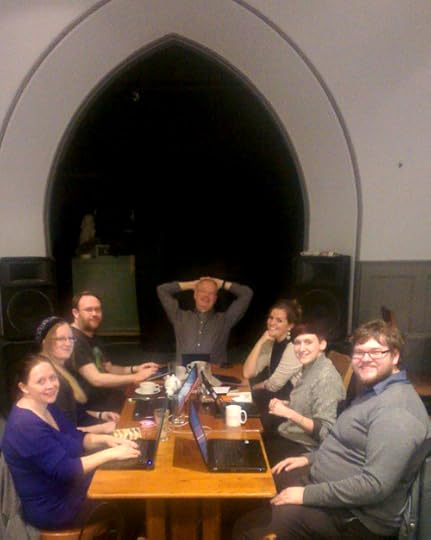

Richard is returning to Kent as NaNoWriMo ML for the second time. He usually writes thriller and suspense novels, but may be attempting a completely different genre this year. When not writing, he helps out at a number of local charity events supporting individuals in need, as well as assists with the running of national call centres raising funds.
"Here’s the million-dollar question: how are you going to write this book if you’re afraid to start..."
Give your friend Doubt a name, and then block his calls.”
- kamigarcia on the lies self-doubt tells every author.
October 27, 2014
Road Trip to NaNo: Why NaNo Works Best With Other People
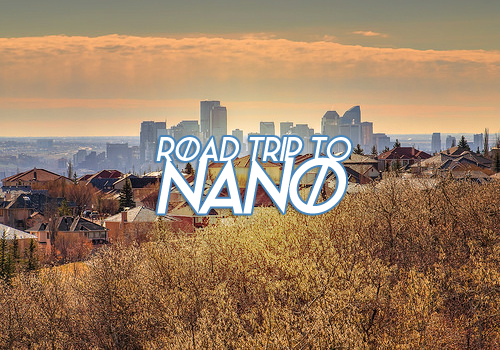
NaNoWriMo is an international event, and the stories being written every year reflect our hundreds of participating regions. We’re taking a Road Trip to NaNo to hear from our amazing volunteers and writers all around the world. Today, Candice, one of our Municipal Liaisons in the Canada :: Alberta :: Calgary region talks about how community can carry you through a storm:
Calgary, Alberta, Canada is known for two things: the Calgary Stampede and the weather. Our summers are cool to moderate and our winters range from moderately cold to very cold. We have had a foot of snow on September 9. and barbecued steaks on Christmas Eve. In the winter we can go from ‘uncovered skin freezes in 60 seconds’ to ‘you don’t need a jacket’ in a matter of hours. Our weather is notoriously unpredictable and Calgarians pride ourselves on that. Don’t like the weather here? Wait five minutes.
Of course, that didn’t help us last year.
In June of 2013, Alberta had record rainfall and snowmelt that culminated in massive floods in most of the southern areas of the province. The two rivers that pass through Calgary both had 1-in-100-year levels and flooded the city. The damage across the province was estimated at between $3 and $5 billion.
But the story that we remember most about the floods was that of the community that rose up during the recovery efforts…
In the days after the flood, the city asked for 600 volunteers to help with cleanup efforts in key areas. 2,500 people showed up, and most had to be sent home. Donations of food and supplies were so high that they exceeded the demand. Of the 75,000 people evacuated, only about 1,500 needed to use the evacuation shelters because the rest were taken in by other people. On that day, more so than on any other, Calgary truly became a community.
This banding together of strangers is a lesson that we can all take forward into our writing. It is possible to do NaNoWriMo on your own, as so many participants have found. The thing is that it’s harder, and way less fun, without a community. In Calgary, our NaNo community is so strong that we meet regularly, not just in November.
As Calgary proved in June 2013, you can weather any storm with the right help. So, as you prepare for NaNoWriMo 2014, build your community.
Tell everyone you’re doing NaNo (this works better with people you already know, but feel free to tell random people on the street if you want to). Even better: tell them how they can help you. Best of all: convince them to do NaNo with you and challenge each other to improve your best word count or double the daily goal.
Go to your regional events (especially if they have pre-NaNo planning events) or to your local Come Write In event. Talk to new people and make friends. See what other people are writing about and if there is anything that appeals to you. Ask for help building your characters, defining your world, or organizing your plot arcs. There’s a word of information available from this community if you only ask.
And if you don’t have an active region, or can’t make it out to the event, find new friends through the NaNoWriMo.org forums. Nothing says that you can’t make your own community, even if it is not in person.
As a bonus challenge: ask one of these new friends to give you a person or a thing to include in your novel. You may just find yourself writing about something awesome.
Candice Robinson is an engineer and a writer from Calgary, Alberta, Canada. She is married to another writer and they are owned by two cats. 2014 will be her tenth National Novel Writing Month and her fifth as a Municipal Liaison working with her fabulous co-ML Josiah Ditoro (Xanateria). When she’s not writing, engineering, or helping Wrimos to take over the world, she enjoys reading, knitting, and running.
Top photo by Flickr user MSVG.
October 26, 2014
Road Trip to NaNo: The Beauty of Your Messy Draft

NaNoWriMo is an international event, and the stories being written every year reflect our hundreds of participating regions. We’re taking a Road Trip to NaNo to hear from our amazing volunteers and writers all around the world. Today, Victoria, one of our Municipal Liaisons in the Canada :: Ontario :: Toronto region compares your novel to a song:
It’s past midnight, and I’m wandering a surreal version of downtown Toronto. Mixed in with the office towers, restaurants, and the university, the city glitters with snatches of the arcane and bizarre: a massive balloon spider that menaces from above, a gauzy maze in a parking lot, a glittering rainbow that arcs overhead to land on the CN Tower.
People are wandering the closed streets in pairs or in groups, and there’s a festival atmosphere everywhere. In the dark, Toronto seems simultaneously deserted and inhabited by friendly spirits.
This is Nuit Blanche…
The all-night art festival has a lot in common with NaNoWriMo, actually—starting with the complete insanity of co-opting Canada’s largest city once a year for an overnight art spree. Nuit Blanche brings out the wild, wacky, and mysterious; it puts pockets of wonder and chaos around every corner.
This year, what brought me to Nuit Blanche was a performance piece featuring a series of vocalists and choirs, and I was charmed by a creative decision made by one of the groups. Rather than perfected pieces, they chose to showcase works-in-progress to the Nuit Blanche crowd, opening their messy rehearsal for us to share.
Practicing with a choir is always an iterative process, and so is writing a novel. There’s nothing like the joy of feeling the notes finally soar as you polish a song toward perfection—except, maybe, the glory of watching your novel draft develop on the page… one stolen minute at a time, a single word at a time, building toward the epic crescendo of your climactic scenes.
There’s another thing that rehearsing with a choir has in common with drafting a novel: it’s all too easy to compare your rough, sloppy starting point with other people’s finished performances. Don’t do it! Every novel starts with a messy first draft. That’s what the editing process is there for. Every choir starts working on a new song in pieces, repeating a few bars at a time until they glow.
At Nuit Blanche, we were gifted with the chance to see a choir “perform” their rehearsal process for us—and a reminder that no one else’s polished performance piece ever leapt perfect from the page on their first try. Every novel you see on the shelf has been through the same process as yours. What you’ll be working on in November is a first draft, not a finished song.
For now, my challenge is simple: Give yourself permission to try something new in your novel. Give yourself the opportunity to fail. Don’t feel pressured to churn out perfection on your first try—not even a trained choir can do that!
Don’t delete anything. Not even the mess.
And keep writing.
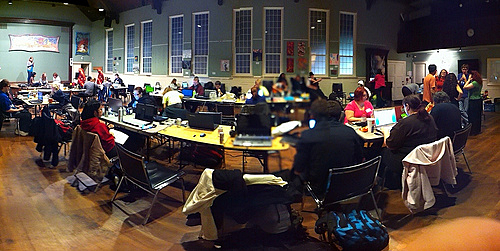

Victoria Anisman-Reiner is aiming for her tenth consecutive NaNo win in 2014. This will also be her sixth year as a Toronto ML. When she’s not reading, writing, waitressing, walking dogs, rewatching BSG, or talking about NaNoWriMo to random strangers, she’s usually sleeping. She does two of these seven things professionally and less of the other five than she’d like.
Top photo by Flickr user Eric.Parker.
October 25, 2014
We Need Diverse Books: How to Prepare to Write a Diverse Book
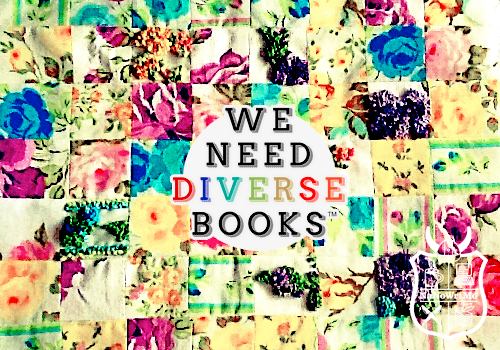
Love diversity in your fiction? Support We Need Diverse Books’ Indiegogo campaign!
Throughout October, we’ve partnered with We Need Diverse Books to bring you a series of blog posts full of helpful advice, tips, and suggestions for writing diversity convincingly and respectfully in your fiction—from people who know what they’re talking about. Today, I. W. Gregorio shows you exactly how to prepare to write a diverse book:
So you wanna write a diverse book? Awesome. Great diverse books can change lives. But as Spider-Man taught us: “With great power there must also come great responsibility.”
In her previous post, Ellen Oh quoted the brilliant Gene Luen Yang, who laid down the gospel:
“Make sure you do your homework.”
You can work on this homework at any point in the process, but I personally find it helpful to do it in the earliest stages. Because everybody needs help with their homework sometime, I’ve got five resources for writers researching a diverse book (or any book, for that matter):
Your friends. This seems like a no-brainer, but a surprising number of people are shy about reaching out to people they know. Personally, whenever I’ve tried to speak to people about their areas of experience, whether that be having a gay dad, living in China, or being a social worker, they’ve been flattered by the attention.
Think of your “research” as a way for you to bond with your friend over something that is an integral part of their life. One caveat to this point, though: remember that no one person can give you all the answers. It’s best to get multiple points of view, because there’s diversity within diversity.
Primary sources. Gravitate toward primary sources. And by that I mean, Wikipedia is fine to get an overview, but to really understand a topic, go to the footnotes at the bottom and try your best to find the words of the actual people who lived in Laos, or in Cuba during the Missile Crisis.
For example, I initially hit a stumbling block while writing my debut YA novel, None of the Above, because I first thought to look for books on intersex in the Stanford Medical Library. I learned a lot about intersex anatomy that way, but not a ton about what it was actually like to live as intersex. Then I discovered the Androgen Insensitivity Support Group and found an amazing cache of essays written by women with AIS. These primary sources were invaluable tools that allowed me to get in the head of my main character.
The Internet. If you need a place to start, DiversifYA.com is a one-of-a-kind resource run by We Need Diverse Books executive committee member Marieke Nijkamp, and is an amazing collection of interviews & round tables tagged by type of diversity. They also run occasional Twitter chats.
Additional diversity specific links:
CBC Diversity’s Resources for Writers - a fantastic compendium of essays for people writing diverse books
Malinda Lo’s guide to avoiding LGBTQ stereotypes
Mitali Perkins’ checklist for writers writing about race
Disability in Kidlit - interviews, discussions and reviews
Diversity in YA - celebrating all kinds of diversity in YA
Crowd-sourcing. Don’t be afraid to crowdsource to find people to tweet and exchange e-mails with. Better yet, talk to them by phone or by Skype.
Knowing how people of a certain culture speak—the cadence of their voices, their subtle nuances of syntax—can make the difference between a clunky characterization and one that sings. A good example of this is Patricia McCormick’s Never Fall Down, which captures the voice of a Cambodian refugee perfectly.
Other tips
If your story is set in a culture different than your own, consider traveling to the country to soak in the cuisine, hear the language and live in their world (if you can afford this, of course).
Watch news footage and documentaries. Again, focus on primary sources. You can also look for movies that have specifically shot on location.
Google Maps can give you physical details that you can layer into your novel .
One of the best things about writing as opposed to, say, surgery, is that you have numerous opportunities to get it right. There is no limit to how much homework you can do in the service of your story. And trust me… your story will be the better for it.
I. W. Gregorio is a practicing surgeon by day, masked avenging YA writer by night. After getting her MD, she did her residency at Stanford, where she met the intersex patient who inspired her debut novel, None of the Above. She is a founding member of We Need Diverse Books™ and serves as its VP of Development. A recovering ice hockey player, she lives in Pennsylvania with her husband and two children. Find her on Twitter, Tumblr, Facebook, and Instagram.

We Need Diverse Books (WNDB) is a grassroots nonprofit organization created to address the lack of diverse, non-majority narratives in children’s literature. WNDB is committed to the ideal that embracing diversity will lead to acceptance, empathy, and ultimately equality.
WNDB has launched its inaugural Indiegogo campaign to support its future initiatives, including a Diversity in the Classroom program, diverse author grants and awards, and the first ever Diversity Festival in 2016. Volunteer & sign up for its mailing list at diversebooks.org, or follow WNDB on Twitter, Tumblr, Facebook, and Instagram!
Top photo by Flickr user Nesha’s Vintage Niche.
October 24, 2014
Road Trip to NaNo: Preparing Your Ideal Writing Space
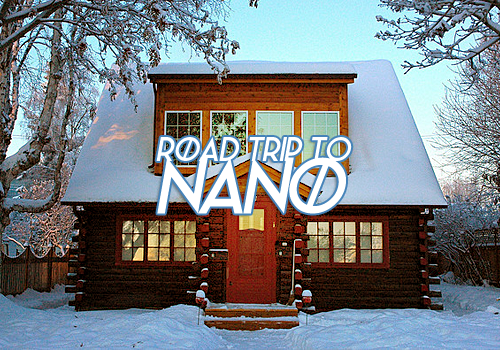
NaNoWriMo is an international event, and the stories being written every year reflect our hundreds of participating regions. We’re taking a Road Trip to NaNo to hear from our amazing volunteers and writers all around the world. Today, Abby, one of our Municipal Liaisons in the USA :: Alaska :: Anchorage region talk organization and setting:
Alaska is a land of extremes. During the winter, we have almost no sunlight at all. Then, on the flip side, we get an overabundance of sunlight in the summer, and have to tape our blinds shut just to get some sleep. Our climate is both beautiful and dangerous. We have a rainforest, and we have deserts. We’re enormous in size, yet have a sparse, small population.
All the extremes that make up the 49th state are what make the land and its inhabitants unique. Stories of Alaska are stories of survival and ingenuity, because even daily living can be an adventure. Ever been late to a meeting because the drive-thru at Taco Bell is blocked by a moose? I have…
Our cold weather climate means thinking about a lot of things that people in the Continental United States might not have to consider. Preparing for NaNoWriMo goes beyond the expected. Most of us have to change our summer tires over for studded just so we can get to the write-ins. Skipping steps can be hazardous—I once neglected to get the heater in my car fixed before NaNoWriMo. Fortunately, I still have all my fingers.
In the weeks leading to November, there is often a lot of emphasis on novel prep, and rightly so. Outlines, research, brainstorming, and the like are very important, but it’s also important to put some time and effort into planning for the writing itself. What does your environment require of you? Not just outside, but your immediate surroundings.
I mentioned some of the big things we do to get ready for NaNo, but there are smaller things, too, such as snipping the fingers off a pair of gloves so you can keep typing when the space heater isn’t cutting it.
Consider your ideal writing space—then consider what you have available. Your surroundings are a crucial part of the writing process. If you’ve ever tried to write a touching, romantic scene while the TV is blaring and your chair is killing your back, then you know what I’m talking about. Maybe you can’t do anything about the TV—roommates will be roommates—but you can keep extra batteries on hand for those noise-canceling headphones.
Get that writing space set-up, and clear it of anything unnecessary, because for the month of November it is a dedicated writing tool. Is everything you’ll need in reach? Notify friends and family to avoid sending panicked texts, and set your DVR to record Doctor Who. Whatever it is your environment requires of you, plan accordingly. Surprises are fun, but I personally prefer a random rhino in my story to running out of hot apple cider at midnight.
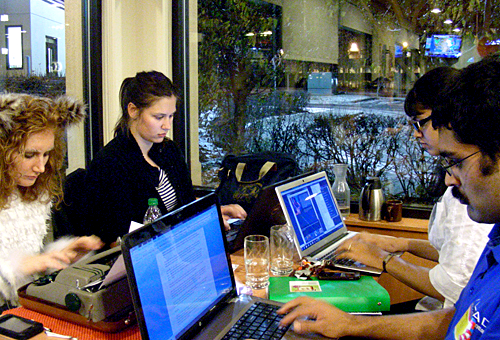

This will be Abby Foster’s fifth year as a Municipal Liaison for the Anchorage community. She writes with a local group affectionately dubbed “WriteClub” and also volunteers as a writing mentor for the Teen Writing Society. “That girl with the typewriter” can usually be found by following the click-clacking sound made by her typewriter, Gus.
Top photo by Flickr user Wonderlane.
Chris Baty's Blog
- Chris Baty's profile
- 63 followers






